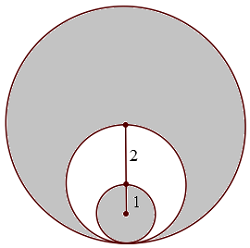SAT Circles
 As shown in the figure above, the three circles are tangent, the middle circle passes through the center of the big circle, and the small circle passes through the center of the middle circle. What is the area of the shaded region?
As shown in the figure above, the three circles are tangent, the middle circle passes through the center of the big circle, and the small circle passes through the center of the middle circle. What is the area of the shaded region?
(A)
(B)
(C)
(D)
(E)
This section requires Javascript.
You are seeing this because something didn't load right. We suggest you, (a) try
refreshing the page, (b) enabling javascript if it is disabled on your browser and,
finally, (c)
loading the
non-javascript version of this page
. We're sorry about the hassle.
Correct Answer: C
Solution:
Tip: Area of a circle with radius r : A ⨀ = π r 2 .
We can infer from the diagram that the radius of the big circle equals the diameter of the middle circle, 4; the radius of the middle circle is 2; and the radius of the small circle is 1.
A shaded = = = = A big − A middle + A small π ⋅ 4 2 − π ⋅ 2 2 + π ⋅ 1 2 1 6 π − 4 π + π 1 3 π
Incorrect Choices:
(A)
If you think the radius of the big circle is 3, you will get this wrong answer. The radius of the big circle is 4.
(B)
If you find A big − A middle − A small , you will get this wrong answer.
(D)
If you find A big + A middle − A small , you will get this wrong answer.
(E)
If you find A big + A middle + A small , you will get this wrong answer.